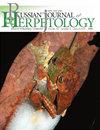Optimizing Protocols for High-Quality RNA Extraction from Blood and Liver Tissues of the Broad-Snouted Caiman
IF 0.9
4区 生物学
Q3 ZOOLOGY
引用次数: 5
Abstract
Transcriptomic information provides fundamental insights into biological processes and can be used to determine gene expression in cell, tissue, or organism under specific physiological conditions, or in response to any environmental perturbation. Extraction of high quality RNA is a challenging step mainly in non-traditional organisms, and protocols for preservation and isolation need to be adjusted in many cases. In the present work, we aimed to develop a protocol for preservation and isolation of high-quality and quantity of RNA from blood and liver tissues of Caiman latirostris. Three preservation methods were tested: 1) flash freezing (LN2) and storage at –80°C; 2) RNAlater® conservation with progressive cooling up to –80°C); 3) preservation in TRIzol® reagent, flash freezing in LN2 and storage at –80°C. Methods 1 and 2 were tested for liver, while 2 and 3 for blood. Our results showed that both preservation methods resulted in excellent outcomes for liver samples. For blood samples however, TRIzol® preservation was an efficient procedure for adequate RNA quality, quantity, and integrity, while conservation in RNAlater® solution was inadequate in both quality and quantity for an optimal RNA extraction. Appropriate protocols were established for each tissue and are being used now for transcriptomic studies in this sentinel organism.宽吻Caiman血、肝组织高质量RNA提取工艺的优化
转录组学信息提供了对生物过程的基本见解,可用于确定特定生理条件下或对任何环境扰动的反应下细胞、组织或生物体中的基因表达。提取高质量RNA主要在非传统生物中是一个具有挑战性的步骤,在许多情况下需要调整保存和分离的方案。在目前的工作中,我们的目标是制定一个保存和分离高质量和数量的拉丁美洲Caiman血液和肝组织RNA的方案。试验了三种保存方法:1)速冻(LN2)和-80°C保存;2) RNAlater®保护,逐步冷却至-80°C);3) 在TRIzol®试剂中保存,在LN2中快速冷冻并在–80°C下储存。方法1和2分别检测肝脏,2和3分别检测血液。我们的研究结果表明,这两种保存方法都能为肝脏样本带来良好的结果。然而,对于血液样本,TRIzol®保存是一种有效的RNA质量、数量和完整性的程序,而在RNAlater®溶液中保存在质量和数量上都不足以实现最佳RNA提取。已经为每个组织制定了适当的方案,目前正在用于这种前哨生物的转录组学研究。
本文章由计算机程序翻译,如有差异,请以英文原文为准。
求助全文
约1分钟内获得全文
求助全文
来源期刊

Russian Journal of Herpetology
ZOOLOGY-
CiteScore
1.70
自引率
0.00%
发文量
29
期刊介绍:
Russian Journal of Herpetology is an international multi-disciplinary journal devoted to herpetology. Russian Journal of Herpetology accepts original papers on ecology, behavior, conservation, systematics, evolutionary morphology, paleontology, physiology, cytology and genetics of amphibians and reptiles.
Types of Contributions:
-original papers
-invited or contributed reviews on specific topics
-short communications on topics of immediate interest, new methods and ideas in progress
-notices of meetings, symposia, and short courses
-book reviews
 求助内容:
求助内容: 应助结果提醒方式:
应助结果提醒方式:


